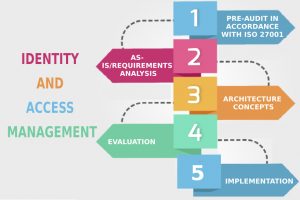Identity and Access management
An acronym for Identity and Access Management, IAM refers to a framework of policies and technologies for ensuring that the proper people in an enterprise have the appropriate access to technology resources. Also called identity management (IdM), IAM systems fall under the overarching umbrella of IT security.

Identity and access management (IAM) is a framework of business processes, policies and technologies that facilitates the management of electronic ordigital Identities With an IAM framework in place, information technology (IT) managers can control user acces to critical information within their organizations. Identity and access management products offer role based acess control, which lets system administrators regulate access to systems or networks based on the roles of individual users within the enterprise.
Benefits of identity and access management
IAM technologies can be used to initiate, capture, record and manage user identities and their related access permissions in an automated manner. This brings an organization the following benefits:
- Access privileges are granted according to one interpretation of policy and all individuals and services are properly authenticated, authorized and audited.
- Companies that properly manage identities have greater control of user access, reducing the risk of internal and externaldata breaches.
- Automating IAM systems allows businesses to operate more efficiently by decreasing the effort, time and money that would be required to manage access to their networks manually.
- In terms of security, the use of an IAM framework can make it easier to enforce policies around user authention validation and privileges and address issues regarding privilege creep.
- IAM systems help companies better comply with government regulations by allowing them to show that corporate information is not being misused. Companies can also demonstrate that any data needed for auditing can be made available on-demand.
Additionally, by implementing identity access management tools and following related best practices, a company can gain a competitive edge. For example, IAM technologies allow the business to give users outside the organization, like customers, partners, contractors and suppliers, access to its network across mobile applications, on-premises apps and software as a service apps without compromising security. This enables better collaboration, enhanced productivity, increased efficiency and reduced operating cost In this context, access is the ability of an individual user to perform a specific task, such as view, create or modify a file. Roles are defined according to job competency, authority and responsibility within the enterprise.
Systems used for identity and access management include single sign-on systems, multi-factor authentication and privileged access management (PAM). These technologies also provide the ability to securely store identity and profile data as well as data governance functions to ensure that only data that is necessary and relevant is shared. IAM systems can be deployed on premises, provided by a third-party vendor through a cloud-based subscription model or deployed in a hybrid cloud.
Basic components of IAM
On a fundamental level, IAM encompasses the following components:
- How individuals are identified in a system.
- How roles are identified in a system and how they are assigned to individuals.
- Adding, removing and updating individuals and their roles in a system.
- Assigning levels of access to individuals or groups of individuals.
- Protecting the sensitive data within the system and securing the system itself.
